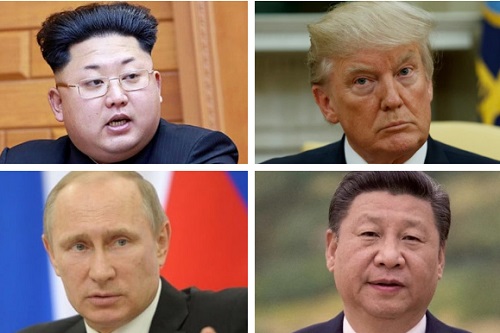By
Tom Arms
It’s time to talk. Nuclear weapons, cyber weapons, drones, robots and rogue nuclear states have combined to move the Doomsday clock to two minutes before midnight.
The last time it was this close to Armageddon was January 1953. Stalin was still in the Kremlin. The Korean War was raging and General MacArthur was pressing for a nuclear attack on China. The Soviets detonated their first atomic bomb in 1949. The Americans exploded their first hydrogen bomb in 1952. Anti-communist witch hunter Senator Joe McCarthy was at the height of his powers. Post war Western Europe was struggling to rise to its knees and the Soviet thumb was busily screwing down Eastern Europe.
The international situation was bad. In 2018—say the committee that moves the hands of the Doomsday clock—it is as bad as the worst it has ever been.
And yet, despite the fear that is creeping into global diplomatic relations, very little is being done to encourage negotiations designed to push the minute hand away from midnight. We have become so obsessed with issues such as immigration, sovereignty and economic growth that we have lost sight of the dangers that threaten to obliterate any political and economic gains.
The dangers are as great now as in 1953 because the weaponry is more frightening and the threats are politically more complex and multipolar. In 1953 it was Moscow v. Washington. In 2018 it is Washington v. Beijing, Moscow v. Washington, Washington v. Tehran, China v. India, Israel v. Iran and the Arab world, North Korea v. Washington, Pakistan v. India, Russia v the EU. Kegs of nuclear gunpowder are scattered across the globe just waiting for the spark to blow us all to kingdom come.
There are now three main protagonists instead of two. In 1953 Mao’s China was closed in on itself. Now it is demanding its rightful place in the world, especially in the Western Pacific. In doing so it is coming up against American power that has filled the vacuum since 1945. Russia, on the other hand, is trying to recover the super power status it lost at the end of the Cold War.
At the moment, the United States has an overwhelming military and technological advantage. But both China and Russia are determined to pursue what they regard as their legitimate interests and are unwilling to accept American military dominance. The US for its part—especially under Donald Trump—is unwilling to make any concessions.
So China and Russia are spending billions to modernise and expand nuclear and conventional arsenals to catch up with the United States. Trump is doing the same in order to stay ahead. And the smaller countries will be forced to modernise if only to remain relevant.
The Chinese and the Russians are not waiting to catch up with America before testing its power. They have developed what analysts call “hybrid warfare”, designed to keep the US preoccupied and off guard. These include computer hacking, cyber warfare, political and economic intelligence, disinformation, economic warfare, criminal activities and political manipulation. They combine these with what is called “grey area warfare” such as Russian activities in Ukraine and Syria and the Chinese in the South China Sea. Grey area warfare involves probing attacks; usually in such a way that a plausible deniability is available in order to plant the seeds of doubt among Western public opinion.
America’s primary response has been to invest more in technology. One of the most frightening results is a super-sonic, pinpoint accurate conventional weapon designed to knock out nuclear weapons before they can be launched. This missile is believed to be near deployment. The Russians and Chinese are frightened of it because it will give the US a first-strike nuclear capability. So, they are developing their own such weapons.
Then there are the drones and the killer robots and artificial intelligence. All these are either already deployed or in the process of development.
A new arms race is on. Because of shifting geopolitics and advancing technology, it is much more frightening than in the Cold War years. The need for diplomatic negotiations is correspondingly greater.
Tom Arms is the author of The Encyclopedia of the Cold War and editor of LookAheadnews.com. Sign up now for the weekly diary of world news events.
LookAhead Radio World Report for week commencing 5 February 2018:
Tom Arms
I am a journalist, entrepreneur and historian with extensive experience in print, web and broadcast journalism. I started as a diplomatic correspondent, wrote several books (The Falklands Crisis, World Elections On File and the Encyclopedia of the Cold War), and then in 1987 started my own business (Future Events News Service, www.fensinformation.com) which over 25 years established itself as the world and UK media’s diary. Our strapline was: “We set the world’s news agenda.” I sold FENS in December 2012 but retained the exclusive broadcast rights to all of FENS data. To exploit these rights I set up LookAhead TV which produces unique programmes which “Broadcasts Tomorrow Today” so that viewers can “Plan to Participate.” LookAhead has appeared regularly on Vox Africa, Radio Tatras International, The Conversation and Voice of Africa Radio.
In addition to being a syndicated broadcaster and columnist on global affairs, Tom is also available for speaking engagements and can be contacted on Twitter, Linkedin and email: [email protected].



No Comments Yet!
You can be first to comment this post!